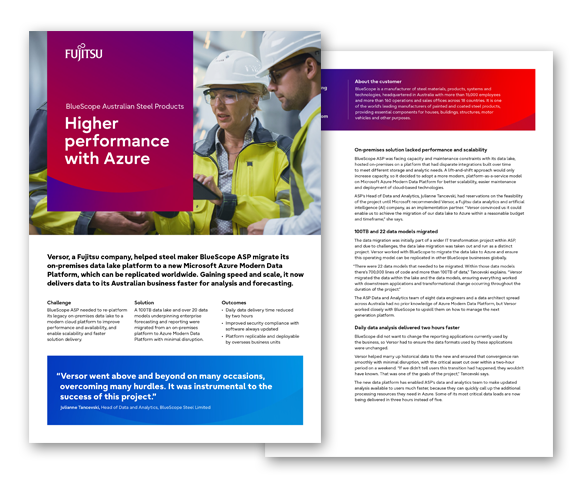Versor, a Fujitsu company, helped steel maker BlueScope ASP migrate its on-premises data lake platform to a new Microsoft Azure Modern Data Platform, which can be replicated worldwide. Gaining speed and scale, it now delivers data to its Australian business faster for analysis and forecasting.
Challenge
BlueScope ASP needed to re-platform its legacy on premises data lake to a modern cloud platform to improve performance and availability, and enable scalability and faster solution delivery.
Solution
A 100TB data lake and over 20 data models underpinning enterprise forecasting and reporting were migrated from an on-premises platform to Azure Modern Data Platform with minimal disruption.
Outcomes
- Daily data delivery time reduced by two hours
- Improved security compliance with software always updated
- Platform replicable and deployable by overseas business units
Versor went above and beyond on many occasions, overcoming many hurdles. It was instrumental to the success of this project.
Julianne Tancevski, Head of Data and Analytics, BlueScope Steel Limited

40%
speed to deliver daily data reduced from five hours to three
- Industry: Manufacturing
- Location: Australia
- Customer's website

About the customer
BlueScope is a manufacturer of steel materials, products, systems and technologies, headquartered in Australia with more than 15,000 employees and more than 160 operations and sales of fices across 18 countries. It is one of the world’s leading manufacturers of painted and coated steel products, providing essential components for houses, buildings, structures, motor vehicles and other purposes.
On-premises solution lacked performance and scalability
BlueScope ASP was facing capacity and maintenance constraints with its data lake, hosted on-premises on a platform that had disparate integrations built over time to meet different storage and analytic needs. A lift-and-shift approach would only increase capacity, so it decided to adopt a more modern, platform-as-a-service model on Microsoft Azure Modern Data Platform for better scalability, easier maintenance and deployment of cloud-based technologies.
ASP’s Head of Data and Analytics, Julianne Tancevski, had reservations on the feasibility of the project until Microsoft recommended Versor, a Fujitsu data analytics and artificial intelligence (AI) company, as an implementation partner. “Versor convinced us it could enable us to achieve the migration of our data lake to Azure within a reasonable budget and timeframe,” she says.
100TB and 22 data models migrated
The data migration was initially part of a wider IT transformation project within ASP, and due to challenges, the data lake migration was taken out and run as a distinct project. Versor worked with BlueScope to migrate the data lake to Azure and ensure this operating model can be replicated in other BlueScope businesses globally.
“There were 22 data models that needed to be migrated. Within those data models there’s 700,000 lines of code and more than 100TB of data,” Tancevski explains. “Versor migrated the data within the lake and the data models, ensuring everything worked with downstream applications and transformational change occurring throughout the duration of the project.”
The ASP Data and Analytics team of eight data engineers and a data architect spread across Australia had no prior knowledge of Azure Modern Data Platform, but Versor worked closely with BlueScope to upskill them on how to manage the next generation platform.
Daily data analysis delivered two hours faster
BlueScope did not want to change the reporting applications currently used by the business, so Versor had to ensure the data formats used by these applications were unchanged.
Versor helped marry up historical data to the new and ensured that convergence ran smoothly with minimal disruption, with the critical asset cut over within a two-hour period on a weekend. “If we didn’t tell users this transition had happened, they wouldn’t have known. That was one of the goals of the project,” Tancevski says.
The new data platform has enabled ASP’s data and analytics team to make updated analysis available to users much faster, because they can quickly call up the additional processing resources they need in Azure. Some of its most critical data loads are now being delivered in three hours instead of five.
With faster delivery of data assets and no capacity issues, ASP can leverage a single platform for many different applications and functions, and along with this migration, it is now using AI to improve forecasting and predictive analysis.
Tancevski plans to leverage Azure to build more data assets to provide actionable insights and solve more problems. A data catalogue to support a self-service data analytics programme to accelerate end-user capability is also in the pipeline.








